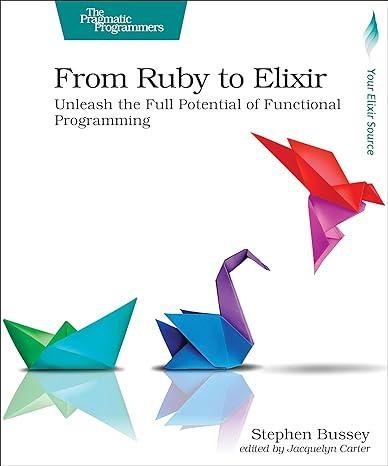From Ruby to Elixir by Stephen Bussey Book in EPUB Format
Stephen Bussey's book "From Ruby to Elixir" is a comprehensive guide designed for developers transitioning from Ruby to Elixir. The book, available in EPUB format, provides an in-depth look at the two programming languages, emphasizing Elixir's unique features and advantages. This article delves into the contents of Bussey's book, highlighting key takeaways and benefits for Ruby developers exploring the Elixir landscape.
Introduction to Elixir and Ruby
Ruby, a dynamic, open-source programming language with a focus on simplicity and productivity, has been a favorite among developers for web development, particularly with the Ruby on Rails framework. Elixir, on the other hand, is a functional, concurrent, general-purpose programming language that runs on the Erlang virtual machine (BEAM). Elixir is known for its scalability and fault-tolerance, making it an excellent choice for distributed systems and high-availability applications.
Stephen Bussey: The Author
Stephen Bussey is an experienced software developer with a strong background in Ruby and Elixir. His expertise in both languages allows him to provide valuable insights and practical advice for developers making the transition. Bussey's book is a result of his extensive experience and deep understanding of the intricacies of both languages.
Why Transition from Ruby to Elixir?
Bussey begins by addressing the reasons why developers might consider transitioning from Ruby to Elixir. While Ruby is excellent for rapid development and has a vibrant community, Elixir offers several advantages, especially for modern, scalable applications. Some key reasons for the transition include:
- Concurrency: Elixir's concurrency model, based on the Actor model, allows for the creation of highly concurrent applications with ease.
- Fault Tolerance: Elixir, running on the BEAM, inherits Erlang's robust fault-tolerant features, making it ideal for systems that require high availability.
- Performance: Elixir's performance, particularly for applications with high levels of concurrent processing, can be superior to Ruby.
- Ecosystem: The Elixir ecosystem, including the Phoenix framework, provides powerful tools for web development, akin to Ruby on Rails but optimized for performance and scalability.
Core Concepts and Syntax Differences
Bussey's book meticulously covers the core concepts and syntax differences between Ruby and Elixir. This section is crucial for Ruby developers to understand the fundamental changes in thinking and coding style required when moving to Elixir.
Functional Programming
One of the most significant shifts is the move from Ruby's object-oriented paradigm to Elixir's functional programming paradigm. Bussey explains the benefits of functional programming, such as immutability, first-class functions, and the emphasis on pure functions, which lead to more predictable and maintainable code.
Pattern Matching
Elixir's pattern matching is a powerful feature that simplifies code and enhances readability. Bussey provides numerous examples to illustrate how pattern matching can be used effectively in various scenarios, contrasting it with Ruby's approach to similar problems.
Pipe Operator
The pipe operator (|>) in Elixir allows for a more natural and readable chaining of function calls. Bussey demonstrates how this operator can make code more concise and easier to follow compared to Ruby's method chaining.
Concurrency and Processes
Elixir's concurrency model, built on lightweight processes, is one of its standout features. Bussey dives into the mechanics of creating and managing processes, comparing it to Ruby's threading model. He explains how Elixir's approach can lead to more efficient and scalable applications.
Practical Examples and Case Studies
To solidify the concepts, Bussey includes numerous practical examples and case studies. These examples range from simple scripts to more complex applications, showcasing the strengths of Elixir in real-world scenarios.
Building a Web Application with Phoenix
One of the key examples is building a web application using the Phoenix framework. Bussey guides readers through the process, from setting up a new Phoenix project to deploying a fully functional web application. He highlights the similarities and differences between Phoenix and Ruby on Rails, making it easier for Ruby developers to grasp the new concepts.
Distributed Systems and Microservices
Bussey also explores the creation of distributed systems and microservices using Elixir. He explains how Elixir's features, such as lightweight processes and message passing, make it an ideal choice for building scalable and maintainable microservices architectures.
Tools and Resources
In addition to practical examples, Bussey provides an extensive list of tools and resources to aid in the transition. This includes recommended libraries, frameworks, and community resources that can help Ruby developers get up to speed with Elixir more quickly.
Stephen Bussey's "From Ruby to Elixir" is an invaluable resource for developers looking to make the switch. The book's thorough coverage of core concepts, practical examples, and insightful comparisons between Ruby and Elixir make it a must-read for anyone interested in exploring the benefits of Elixir. The availability of the book in EPUB format ensures that it is accessible to a wide audience, allowing developers to conveniently read and reference the material on various devices.
In summary, "From Ruby to Elixir" not only serves as a guide for transitioning from one language to another but also as a testament to the growing importance of Elixir in the modern programming landscape. Whether you are a seasoned Ruby developer or a newcomer to functional programming, Bussey's book provides the knowledge and tools necessary
